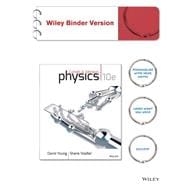WileyPLUS sold separately from text.
Cutnell and Johnson’s Physics has been the #1 text in the algebra-based physics market for almost 20 years. Physics, 10th Edition brings on new co-authors: David Young and Shane Stadler (both out of LSU). The Cutnell offering now includes enhanced features and functionality. The authors have been extensively involved in the creation and adaptation of valuable resources for the text. The 10th edition includes 160 New Chalkboard videos, guided online tutorials in every chapter, and vector drawing questions. All of these features are designed to encourage students to remain within the WileyPLUS environment, as opposed to pursuing the “pay-for-solutions” websites that short circuit the learning process.








